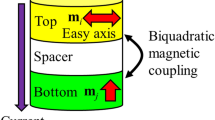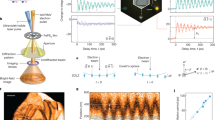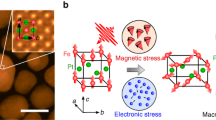Abstract
Spin–rotation coupling (SRC) is a fundamental interaction that connects electronic spins with the rotational motion of a medium. We elucidate the Einstein–de Haas (EdH) effect and its inverse with SRC as the microscopic mechanism using the dynamic spin–lattice equations derived by elasticity theory and Lagrangian formalism. By applying the coupling equations to an iron disk in a magnetic field, we exhibit the transfer of angular momentum and energy between spins and lattice, with or without damping. The timescale of the angular momentum transfer from spins to the entire lattice is estimated by our theory to be on the order of 0.01 ns, for the disk with a radius of 100 nm. Moreover, we discover a linear relationship between the magnetic field strength and the rotation frequency, which is also enhanced by a higher ratio of Young’s modulus to Poisson’s coefficient. In the presence of damping, we notice that the spin-lattice relaxation time is nearly inversely proportional to the magnetic field. Our explorations will contribute to a better understanding of the EdH effect and provide valuable insights for magneto-mechanical manufacturing.

Similar content being viewed by others
References
J. E. Losby, V. T. K. Sauer, and M. R. Freeman, Recent advances in mechanical torque studies of small-scale magnetism, J. Phys. D Appl. Phys. 51(48), 483001 (2018)
S. R. Tauchert, M. Volkov, D. Ehberger, D. Kazenwadel, M. Evers, H. Lange, A. Donges, A. Book, W. Kreuzpaintner, U. Nowak, and P. Baum, Polarized phonons carry angular momentum in ultrafast demagnetization, Nature 602(7895), 73 (2022)
O. W. Richardson, A mechanical effect accompanying magnetization, Phys. Rev. Ser. I 26(3), 248 (1908)
A. Einstein, Experimenteller nachweis der ampereschen molekularströme, Naturwissenschaften 3(19), 237 (1915)
S. J. Barnett, Magnetization by rotation, Phys. Rev. 6(4), 239 (1915)
A. Einstein and W. De Haas, Experimental proof of the existence of Ampère’s molecular currents, in: Prcc. KNAW, Vol. 181 (1915), p. 696
G. G. Scott, Review of gyromagnetic ratio experiments, Rev. Mod. Phys. 34(1), 102 (1962)
W. Górecki and K. Rzażewski, Making two dysprosium atoms rotate — Einstein–de Haas effect revisited, Europhys. Lett. 116(2), 26004 (2016)
T. Wells, A. P. Horsfield, W. M. C. Foulkes, and S. L. Dudarev, The microscopic Einstein–de Haas effect, J. Chem. Phys. 150(22), 224109 (2019)
S. A. Wolf, D. D. Awschalom, R. A. Buhrman, J. M. Daughton, S. von Molnár, M. L. Roukes, A. Y. Chtchelkanova, and D. M. Treger, Spintronics: A spin-based electronics vision for the future, Science 294(5546), 1488 (2001)
Z. Xiong, D. Wu, Z. Valy Vardeny, and J. Shi, Giant magnetoresistance in organic spin-valves, Nature 427(6977), 821 (2004)
S. Sanvito and A. R. Rocha, Molecular-spintronics: The art of driving spin through molecules, J. Comput. Theor. Nanosci. 3(5), 624 (2006)
L. Bogani and W. Wernsdorfer, Molecular spintronics using single-molecule magnets, Nat. Mater. 7(3), 179 (2008)
E. Chudnovsky, D. Garanin, and R. Schilling, Universal mechanism of spin relaxation in solids, Phys. Rev. B 72(9), 094426 (2005)
E. M. Chudnovsky and D. A. Garanin, Rotational states of a nanomagnet, Phys. Rev. B 81(21), 214423 (2010)
E. M. Chudnovsky, Conservation of angular momentum in the problem of tunneling of the magnetic moment, Phys. Rev. Lett. 72(21), 3433 (1994)
L. Zhang and Q. Niu, Angular momentum of phonons and the Einstein–de Haas effect, Phys. Rev. Lett. 112(8), 085503 (2014)
S. Streib, Difference between angular momentum and pseudoangular momentum, Phys. Rev. B 103(10), L100409 (2021)
J. J. Nakane and H. Kohno, Angular momentum of phonons and its application to single-spin relaxation, Phys. Rev. B 97(17), 174403 (2018)
D. A. Garanin and E. M. Chudnovsky, Angular momentum in spin–phonon processes, Phys. Rev. B 92(2), 024421 (2015)
M. Ganzhorn, S. Klyatskaya, M. Ruben, and W. Wernsdorfer, Quantum Einstein–de Haas effect, Nat. Commun. 7(1), 11443 (2016)
M. Aßmann and U. Nowak, Spin–lattice relaxation beyond gilbert damping, J. Magn. Magn. Mater. 469, 217 (2019)
D. Perera, M. Eisenbach, D. M. Nicholson, G. M. Stocks, and D. P. Landau, Reinventing atomistic magnetic simulations with spin–orbit coupling, Phys. Rev. B 93(6), 060402 (2016)
P. W. Ma, C. H. Woo, and S. L. Dudarev, Large-scale simulation of the spin-lattice dynamics in ferromagnetic iron, Phys. Rev. B 78(2), 024434 (2008)
W. Dednam, C. Sabater, A. Botha, E. Lombardi, J. Fernández-Rossier, and M. Caturla, Spin-lattice dynamics simulation of the Einstein–de Haas effect, Comput. Mater. Sci. 209, 111359 (2022)
T. M. Wallis, J. Moreland, and P. Kabos, Einstein–de Haas effect in a NiFe film deposited on a microcan-tilever, Appl. Phys. Lett. 89(12), 122502 (2006)
R. Jaafar, E. M. Chudnovsky, and D. A. Garanin, Dynamics of the Einstein–de Haas effect: Application to a magnetic cantilever, Phys. Rev. B 79(10), 104410 (2009)
E. M. Chudnovsky and D. A. Garanin, Damping of a nanocantilever by paramagnetic spins, Phys. Rev. B 89(17), 174420 (2014)
E. Beaurepaire, J. C. Merle, A. Daunois, and J. Y. Bigot, Ultrafast spin dynamics in ferromagnetic nickel, Phys. Rev. Lett. 76(22), 4250 (1996)
E. Carpene, E. Mancini, C. Dallera, M. Brenna, E. Puppin, and S. De Silvestri, Dynamics of electron–magnon interaction and ultrafast demagnetization in thin iron films, Phys. Rev. B 78(17), 174422 (2008)
M. Fähnle, Ultrafast demagnetization after femtosecond laser pulses: A complex interaction of light with quantum matter, in: Spintronics XI, Vol. 10732 (SPIE, 2018), p. 107322G
C. Dornes, Y. Acremann, M. Savoini, M. Kubli, M. J. Neugebauer, E. Abreu, L. Huber, G. Lantz, C. A. Vaz, H. Lemke, E. M. Bothschafter, M. Porer, V. Esposito, L. Rettig, M. Buzzi, A. Alberca, Y. W. Windsor, P. Beaud, U. Staub, D. Zhu, S. Song, J. M. Glownia, and S. L. Johnson, The ultrafast Einstein–de Haas effect, Nature 565(7738), 209 (2019)
L. D. Landau, The Classical Theory of Fields, Vol. 2, Elsevier, 2013
R. S. Fishman, J. S. Gardner, and S. Okamoto, Orbital angular momentum of magnons in collinear magnets, Phys. Rev. Lett. 129, 167202 (2022)
J. N. Reddy, Theory and Analysis of Elastic Plates and Shells, CRC press, 2006
L. D. Landau, E. M. Lifšic, E. M. Lifshitz, A. M. Kosevich, and L. P. Pitaevskii, Theory of Elasticity: Volume 7, Vol. 7, Elsevier, 1986
A. I. Lurie, Theory of Elasticity, Springer Science & Business Media, 2010
G. M. Wysin, Magnetic Excitations and Geometric Confinement, IOP Publishing, 2015, pp 2053–2563
R. Courant, K. Friedrichs, and H. Lewy, On the partial difference equations of mathematical physics, IBM J. Res. Develop. 11(2), 215 (1967)
K. Abe, N. Higashimori, M. Kubo, H. Fujiwara, and Y. Iso, A remark on the Courant-Friedrichs-Lewy condition in finite difference approach to pde’s, Adv. Appl. Math. Mech. 6(5), 693 (2014)
Runge-Kutta and extrapolation methods, in: Solving Ordinary Differential Equations I: Nonstiff Problems, Berlin, Heidelberg: Springer, 1993, pp 129–353
B. Koopmans, J. J. M. Ruigrok, F. D. Longa, and W. J. M. de Jonge, Unifying ultrafast magnetization dynamics, Phys. Rev. Lett. 95(26), 267207 (2005)
H. Chudo, M. Ono, K. Harii, M. Matsuo, J. Ieda, R. Haruki, S. Okayasu, S. Maekawa, H. Yasuoka, and E. Saitoh, Observation of Barnett fields in solids by nuclear magnetic resonance, Appl. Phys. Express 7(6), 063004 (2014)
H. Chudo, K. Harii, M. Matsuo, J. Ieda, M. Ono, S. Maekawa, and E. Saitoh, Rotational Doppler effect and Barnett field in spinning NMR, J. Phys. Soc. Jpn. 84(4), 043601 (2015)
M. Ono, H. Chudo, K. Harii, S. Okayasu, M. Matsuo, J. Ieda, R. Takahashi, S. Maekawa, and E. Saitoh, Barnett effect in paramagnetic states, Phys. Rev. B 192(17), 174424 (2015)
M. Arabgol and T. Sleator, Observation of the nuclear Barnett effect, Phys. Rev. Lett. 122(17), 177202 (2019)
J. Xu, B. A. Li, W. Q. Shen, and Y. Xia, Dynamical effects of spin-dependent interactions in low- and intermediate-energy heavy-ion reactions, Front. Phys. 10(6), 102501 (2015)
Y. Xia and J. Xu, Nucleon spin polarization in intermediate-energy heavy-ion collisions, Phys. Lett. B 800, 135130 (2020)
R. J. Liu and J. Xu, Revisiting angular momentum conservation in transport simulations of intermediate-energy heavy-ion collisions, Universe 9(1), 36 (2023)
R. Takahashi, M. Matsuo, M. Ono, K. Harii, H. Chudo, S. Okayasu, J. Ieda, S. Takahashi, S. Maekawa, and E. Saitoh, Spin hydrodynamic generation, Nat. Phys. 12(1), 52 (2016)
M. Matsuo, Y. Ohnuma, and S. Maekawa, Theory of spin hydrodynamic generation, Phys. Rev. B 96(2), 020401 (2017)
J. Li, J. Feng, P. Wang, E. Kan, and H. Xiang, Nature of spin–lattice coupling in two-dimensional CrI3 and CrGeTe3, Sci. China Phys. Mech. Astron. 64(8), 286811 (2021)
J. Hellsvik, D. Thonig, K. Modin, D. Iuşan, A. Bergman, O. Eriksson, L. Bergqvist, and A. Delin, General method for atomistic spin–lattice dynamics with first-principles accuracy, Phys. Rev. B 99(10), 104302 (2019)
B. Sadhukhan, A. Bergman, Y. O. Kvashnin, J. Hellsvik, and A. Delin, Spin–lattice couplings in two-dimensional CrI3 from first-principles computations, Phys. Rev. B 105(10), 104418 (2022)
X. Z. Lu, X. Wu, and H. J. Xiang, General microscopic model of magnetoelastic coupling from first principles, Phys. Rev. B 91(10), 100405 (2015)
J. Li, T. Datta, and D. X. Yao, Einstein–de Haas effect of topological magnons, Phys. Rev. Res. 3(2), 023248 (2021)
M. Matsuo, J. Ieda, E. Saitoh, and S. Maekawa, Effects of mechanical rotation on spin currents, Phys. Rev. Lett. 106(7), 076601 (2011)
M. Matsuo, J. Ieda, K. Harii, E. Saitoh, and S. Maekawa, Mechanical generation of spin current by spin-rotation coupling, Phys. Rev. B 87(18), 180402 (2013)
J. Ieda, M. Matsuo, and S. Maekawa, Theory of mechanical spin current generation via spin–rotation coupling, Solid State Commun. 198, 52 (2014) (sI: Spin Mechanics)
M. Matsuo, J. Ieda, and S. Maekawa, Mechanical generation of spin current, Front. Phys. (Lausanne) 3, 54 (2015)
Acknowledgements
We thank Kun Cao, Muwei Wu, and Shanbo Chow for the helpful discussions. X. N., J. L., and D. X. Y. are supported by NKRDPC-2022YFA1402802, NSFC-92165204, NKRDPC-2018YFA0306001, NSFC-11974432, and Leading Talent Program of Guangdong Special Projects (201626003). T. D. acknowledges hospitality of KITP. A part of this research was completed at KITP and was supported by the National Natural Science Foundation of China under Grant No. NSFPHY-1748958.
Author information
Authors and Affiliations
Corresponding authors
Ethics declarations
Declarations The authors declare that they have no competing interests and there are no conflicts.
Rights and permissions
About this article
Cite this article
Nie, X., Li, J., Datta, T. et al. A spin–rotation mechanism of Einstein–de Haas effect based on a ferromagnetic disk. Front. Phys. 19, 53201 (2024). https://doi.org/10.1007/s11467-023-1389-9
Received:
Accepted:
Published:
DOI: https://doi.org/10.1007/s11467-023-1389-9




